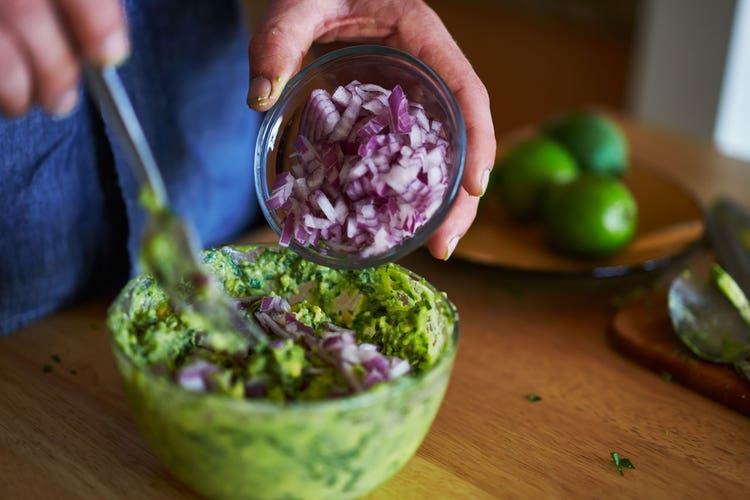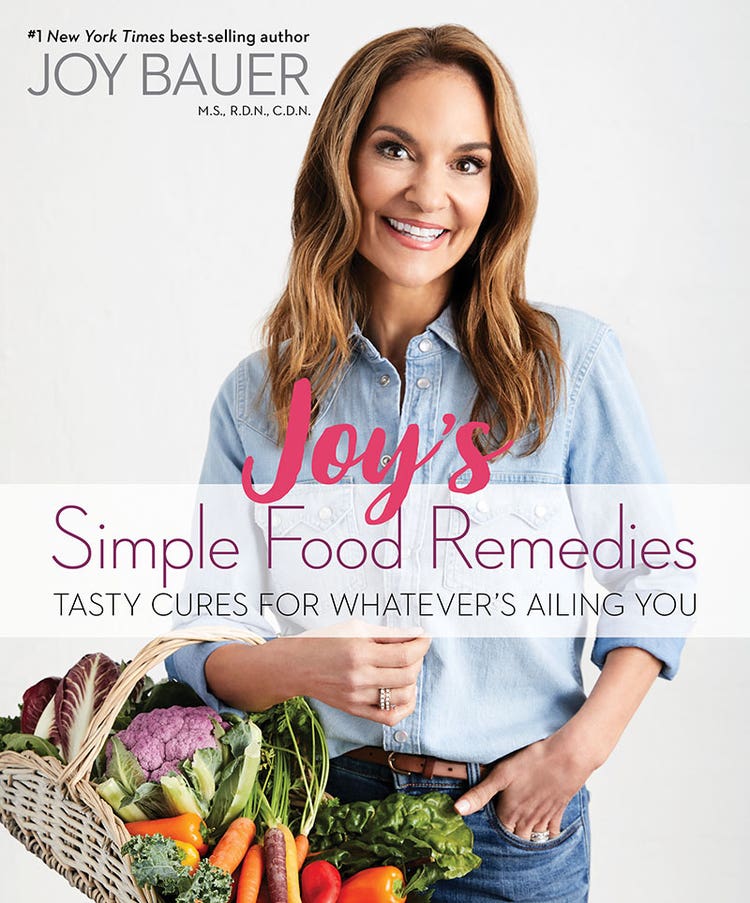Joy Bauer’s Genius Food Hacks for Muscle Aches and More

Experiencing muscle cramps or belly bloat? Who isn’t? Before you book a doctor’s appointment, consider starting in the kitchen, says New York Times best-selling author Joy Bauer, MS, RDN, CDN. In her new book “Joy’s Simple Food Remedies: Tasty Cures for Whatever’s Ailing You” (Hay House, October 2018), the health and nutrition expert for NBC’s “Today” show offers five food remedies for 20 common ailments. Recently, we spoke with Bauer to get the lowdown on a few of her go-to cures and inspired healthful cooking ideas.
24Life: Should people with common ailments (such as belly bloat and headaches) turn to dietary changes first before trying medications or visiting the doctor? How powerful can dietary changes be in treating these types of symptoms?
Joy Bauer: Research has proven over and over again that the compounds in food have the powerful capability to heal. Being that food has no downside, it’s always worth trying first, especially when an ailment appears to be nothing serious, like frustrating bloat or a nagging headache. That being said, if the food fixes don’t offer any relief, it’s always in your best interest to visit with your physician to get a diagnosis and rule out anything serious.
24Life: Which food remedies do you recommend for treating muscle cramps?
JB: Here are three that can help:
- Bananas: One medium banana has nearly 425 milligrams of potassium, a mineral that plays a key role in muscle contraction and function. When you don’t get enough potassium in your diet, your muscles cramp. Bananas also provide a small amount of magnesium, another important mineral that helps with muscle function.
- Milk: Milk is, of course, a great source of bone-building calcium, but the mineral also may help prevent painful muscle spasms. In fact, one of the symptoms of being calcium-deficient is muscle cramps. Milk also contains vitamin D, calcium’s bone-building bestie, which enables calcium to be absorbed by the body and do its job. Milk also chips in a healthy helping of magnesium and potassium. It’s a four-for-one deal—great bargain!
- Edamame: Young, green soybeans that are available either in the pod or shelled are a great source of high-fiber vegetarian protein. Not only that, but they are loaded with potassium (more than 670 milligrams per cup shelled) and contribute about 100 milligrams each of calcium and magnesium to serve up a trio of cramp-busting minerals.
24Life: Which foods do you recommend for minimizing belly fat?
JB: Three of my favorites are:
- Salmon: Salmon is loaded with protein (about 37 grams per 5 ounces cooked), which is more satiating than carbs or fat, so increasing intake will help you feel more satisfied and could help you eat less overall. Salmon can specifically help burn belly fat because it’s one of the richest sources of vitamin D (more than 500 IU, or international units, per 5 ounces cooked). Vitamin D is directly involved with producing hormones that regulate appetite. Consuming enough of the vitamin can reduce the likelihood you’ll overeat. Also, several studies have shown vitamin D is involved with specifically signaling belly-fat cells to burn off.
- Broccoli: One study has shown a relationship between people who consume ample amounts of deep-colored veggies (green, yellow, orange) and lower levels of visceral fat, the dangerous fat around your organs. Plus, these veggies were shown to help reduce inflammation. I specifically chose to focus on broccoli because broccoli is one of the few veggies that contain calcium, which has been shown to increase fat loss, especially around the abdominal area. Not to mention, broccoli is one of the highest-volume, lowest-calorie foods around, so you can eat a large amount and still drop pounds. I think it’s one of the best foods for weight loss in general.
- Greek yogurt: Yogurt, particularly low-fat Greek yogurt, contains satiating protein (about 20 grams per cup, or 17 grams per single container), which is twice as much as traditional yogurt. It can keep you feeling fuller longer and help control your appetite, which can translate to less belly fat. Yogurt is rich in calcium, and two studies have linked calcium to lower levels of abdominal fat. Of course, all the nutrients in food work synergistically, but calcium has been singled out for a few reasons: Experts believe it may help to increase fat burn, reduce fat absorption and slightly rev metabolism. Lastly, yogurt contains probiotics, the beneficial bacteria that help with digestion. And according to a study in Nutrition & Metabolism, probiotics also may promote a healthy weight and midsection.


24Life: In the book, you share so many creative, novel ways to work with nutrient-rich foods. For instance, you suggest that people make “pizza crust” out of pounded-flat boneless, skinless chicken breasts and “jam” with only mango, pineapple and chia seeds. What are some other unusual, delicious and healthy hacks you practice in the kitchen?
JB: I use cauliflower as a lower-carb, lower-calorie substitution for a number of comfort foods, including bread, rice and mashed potatoes. It might sound crazy, but it is so delicious. I also use a bean puree in baked goods, like brownies and cupcakes. It’s so simple. Take a can of rinsed and drained black beans with 1 cup of water, dump in the blender and puree until smooth. Use that to replace the oil and egg in a boxed recipe to cut fat and calories while bumping up protein and fiber. That’s it! The kids won’t even taste the difference. (You also can do this with white beans for vanilla cake and cupcakes.) I also use nonfat Greek yogurt as a slimming and protein-packed substitute for mayo and sour cream in dips, dressings and spreads. It’s also a great topper for potatoes, tacos and chili.
24Life: In the book, you share many nutritional findings that are less commonly known. For instance, carbohydrates can cause water retention (bloating) while potassium can help combat it, protein boosts metabolism more than carbs and fats, and research has linked calcium intake with a flatter belly. What are some other findings that would surprise many readers?
JB: Magnesium-rich foods can help headache sufferers. That’s because the nutrient blocks the transmission of pain chemicals in the brain. It can be especially helpful for women who get migraines during their menstrual cycles. Some of the best sources include quinoa, pumpkin seeds and starchy beans. Extra-virgin olive oil contains a compound that acts as an antihistamine and can help fight against seasonal allergies. The compound is called hydroxytyrosol and seems to help suppress the immune response when people are exposed to allergens.
24Life: Many people avoid dark meat because of its higher fat and calorie content. However, in the book, you recommend it. What do you tell readers who shun dark meat?
JB: Dark-meat turkey, not including skin (think drumsticks and thighs), offers double the amount of iron compared to white meat. Plus, there’s not a big difference when it comes to calories and fat. It will only cost you an extra 25 calories and about 1 gram of saturated fat per 3 ounces. The swap for chicken is even less—about an extra 10 calories and less than half a gram of saturated fat per 3 ounces. So if you like the flavor of dark meat over the breast (dark meat tends to be moister and more flavorful), go for it!

24Life: Similarly, many avoid soy because of cancer fears. However, in the book, you recommend whole soy foods (such as tofu and edamame). What do you tell readers who are afraid of soy?
JB: There’s a lot of fear surrounding soy because of its supposed connection to breast cancer, but research shows eating a moderate amount of whole soy foods (including tofu and edamame) is safe for healthy people. What’s more, some studies, including one paper that analyzed more than 18,000 breast cancer survivors in the United States and China (from The American Journal of Clinical Nutrition), suggest whole soy foods may actually help reduce the risk of a recurrence.
24Life: Throughout the book, you offer tips for maximizing the potency of various nutritious ingredients. For instance, extra-virgin olive oil has the highest level of anti-inflammatory oleocanthal when unheated, curcumin (in turmeric) is best absorbed by the body when accompanied by black pepper (piperine), and fat and plant-based iron is best absorbed by the body when accompanied by vitamin C. Any other tips?
JB: One [nutrition-maximizing pairing] is green tea and lemon: An antioxidant in green tea called EGCG may halt the production of inflammatory chemicals and prevent the buildup of bad cholesterol in the body. And here’s something cool: You’ll get a double bonus by adding a squirt of lemon to your cup. The citrus star allows the body to soak up more of the drink’s healthful compounds, according to several studies.
Another is tomatoes and avocados: The pigment that’s responsible for giving tomatoes their bright orange or red color, lycopene, may help reduce the risk of cancer by preventing damage to DNA and cells. (It also can help reduce wrinkles!) Adding a bit of good fat (avocado is one of my favorite picks!) helps the body soak up the disease-fighting compound. Two tasty ways to put the power pair into play: Mix diced tomatoes into guacamole, or place sliced tomatoes on top of avocado toast (mashed avocado spread on whole-grain toast).
24Life: Do you personally use any of the recipe remedies in your book? Which ones?
JB: Absolutely … my family and I love all of them! Right now, in heavy rotation at the Bauer house are the orange-chamomile blondies (for reducing anxiety and stress), smart smoothie (hey, who doesn’t want some extra brain power?) and savory chicken meatballs with roasted grapes (always looking to rev up my system).
Video credit: Ashley Roman, Shutterstock
Photo credit: Joshua Resnick, Adobe Stock; Courtesy Hay House; sveta_zarzamora, Thinkstock; Mizina, Thinkstock